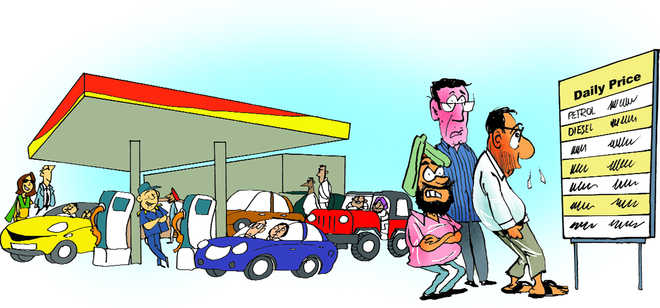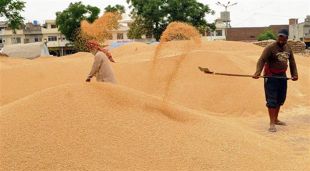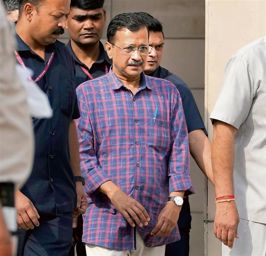
Sandeep Joshi
A large section of the country — farmers, transporters, housewives, students and the salaried class — helplessly watch relentless march of petrol and diesel prices. The government has told them that retail prices of petrol and diesel are market-determined and their volatility is exogenous — prevailing geopolitical uncertainties, anxiety of supply crunch and depreciation of several global currencies including the rupee against the dollar.
India imports more than 80 per cent of crude oil it processes and pays the suppliers in dollar. A weak rupee makes imports of fossil fuels costly. According to the oil ministry's data keeper, fluctuation of exchange rate by Re 1 per dollar has an impact on Rs 10,892 crore on the country's crude oil import bill. The burden of costly imports ultimately falls on the retail consumers.
Global crude oil prices are high mainly because of the volatile situation in the Gulf, plummeting oil output from Venezuela, the US trade dispute with China and the American sanctions against Russia and Iran. A $1 per barrel price variation has an impact of Rs 10,892 crore for India.
Currently, India is hit by a double whammy - while crude oil prices are moving north, the rupee is constantly depreciating against the dollar. Therefore, the impact on the crude oil import bill is huge, which is passed on to the customers. These are part of the official explanation for raising petrol and diesel rates, almost every day.
Lacking transparency
There's more to this than meets the eye. Free market pricing of petrol and diesel does not appear to be completely transparent as it has been projected.
According to official data, Indian refiners imported crude oil (Indian basket) in the rupee term at Rs 5,435.73 per barrel with corresponding retail price of petrol at Rs 79.99 per litre and diesel at Rs 72.02 a litre in Delhi on September 7, 2018.
Interestingly, even when crude oil (Indian basket) was higher at Rs 5,824.55 about four years ago (September 15, 2014), petrol and diesel were sold in Delhi pumps for Rs 68.51 and Rs 58.97 a litre, respectively.
One may argue that only petrol was decontrolled at that time and diesel prices were under the government's control. This issue is also settled by a statement of the petroleum ministry, which was issued on September 16, 2014. It said, "Diesel under-recovery has been wiped out" and there was "over-recovery of Rs 0.35 per litre".
It is, therefore, correct to say that even at a lower price of crude oil import, petrol was cheaper by Rs 11.48 per litre and diesel by Rs 13.05 a litre in the market about four years ago. Now, this is the time to understand the factors that have led to the escalation of other costs. A correct answer could be found only after an independent and unbiased investigation into the pricing mechanism of auto fuels under the so-called free-market system.
Enigmatic formula
There is a perception among citizens that the public display of the daily price buildup for petrol and diesel by state-run oil marketing companies are vague and, therefore, arbitrary. The pricing mechanism is becoming increasingly obscure. Earlier, the price buildup was explained under nine heads, which has now shrunk to seven. A crucial step of the market price determination process - marketing cost, margin, freight and other charges - is conspicuous by its absence. This missing link must also be explained for the satisfaction of the common man that he is not being taken for a ride by oil marketing companies (OMCs).
Besides, the fuel retailers do not disclose the global benchmarks (of crude oil, petrol and diesel), the very basis that determines retail prices of petrol and diesel in the country. Thus, no inquisitive person can decipher the pricing mechanism of these OMCs accurately.
Another enigma is the determination of retail prices of auto fuels on the basis of some unknown global reference rates for petrol and diesel. Interestingly, India's entire auto fuel demands are met from domestic refining of crude oil. According to the refiners, the raw material (crude oil) comprises about 90 per cent of their refining cost. They purchase crude on the long-term basis. According to the basic business understanding, bulk purchase of anything comes with a discount and its value is always less than the price of the commodity in the spot market. It is unpalatable that Indian refiners are bad negotiators despite being the third largest consumer of crude oil after the US and China.
Because of the long-term contract, crude oil rates should not be as volatile as it is in the spot market. Therefore, the market price of petrol and diesel should be determined on the basis of actual per barrel cost of crude oil rather than on the basis of "notional" reference rates prevailing in some distant land that would have a completely different socio-economic condition compared to India.
The market trap
While pricing is one of the key issues that concerns every common citizen of the country, production and consumption of fossil fuel is equally important aspect of the country's energy security that needs immediate attention.
According to official data, India’s domestic crude oil production is dwindling because its explorers have not been able to make any significant discoveries in the last 15 years. State-run energy behemoth ONGC has been a failure in arresting the output decline. The company could produce only 6.7 million metric tonne (MMT) of crude oil in April-July this year, significantly lower than 7.1 MMT produced in the corresponding period last year. It is a matter of grave concern that the company has not been able to make any major success since 1974, after the Mumbai High discovery. Insiders blame vested interests in the oil business and undue political interference behind this calibrated lethargy.
It is highly disturbing that on the one hand domestic oil production is on the decline and on the other hand, petroleum consumption is surging. Domestic consumption of petroleum jumped from 194.6 MMT in 2016-17 to 204.9 MMT in 2017-18, and it is rising. According to official data, the consumption increased to 70.7 MMT in April-July 2018 compared to 67.5 in the same period last year. This shows the failure of government-run alternative fuel programmes, which could not rein in fossil fuel consumption. Consequently, costly crude oil imports are rising unabated. India imported 213.9 MMT of crude oil in 2016-17, which jumped to 220.4 MMT in 2017-18. Even in the current year, the growing consumption pattern is alarming. India imported 76.2 MMT of crude oil in the first four months of the current financial year compared to 71 MMT in the corresponding period last fiscal year. No wonder, India recently became the third largest importer of crude oil surpassing Japan. As India is one of the biggest oil importers after the US and China; powerful oil cartels would not like any dent to their assured market.
Towards security
Indeed, people of the country live in a highly insecure energy environment. Records of petrol and diesel prices break every next day. While the people suffer, the exchequer is making a killing, because fuels are heavily loaded with levies. Petroleum revenues of the Centre and states jumped from Rs 4,13,824 crore in 2015-16 to Rs 5,53,013 crore in 2017-18.
Ideally, the government should soften petrol and diesel rates immediately by reducing duties. The Finance Ministry must now remember its strategy of raising excise duties on petrol and diesel when international oil prices were significantly low. The idea was to create a cushion for the common man for the adverse time when global oil prices march northward. This is the time to honour the commitment by slashing excise duties. States must also follow suit by reducing value-added tax on auto fuels. Eventually, petrol and diesel must be brought under the GST for reasonableness and nationwide uniformity. Besides, relief from high taxes, the government must make petrol and diesel price-determination formula transparent by revealing the secret benchmarks and other hidden components of the pricing mechanism to the public.



























